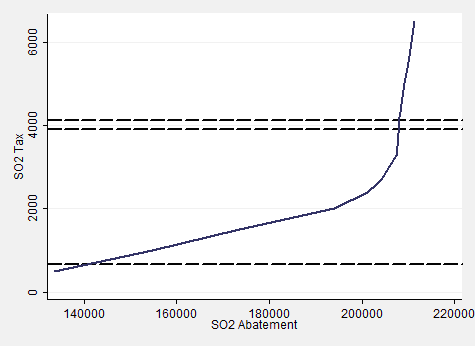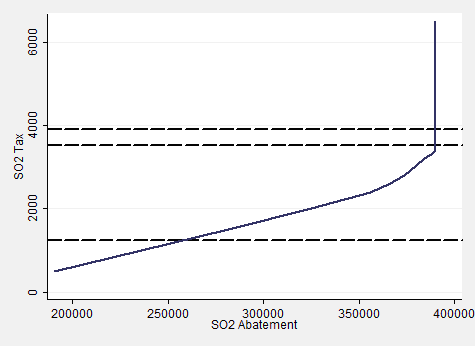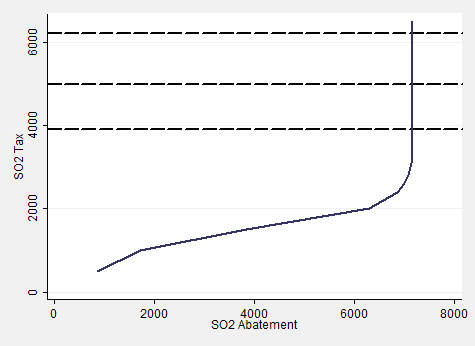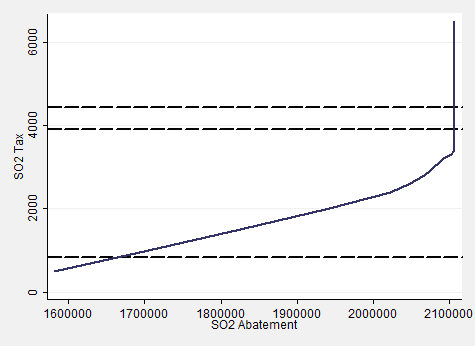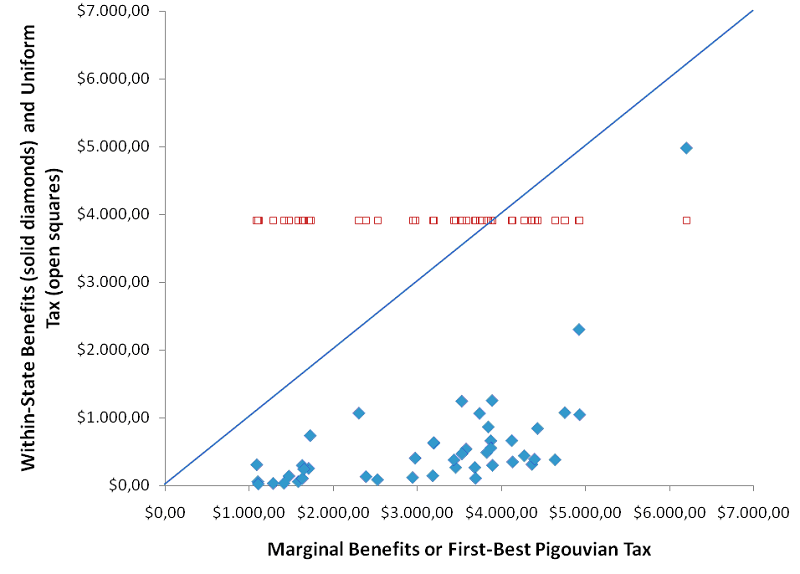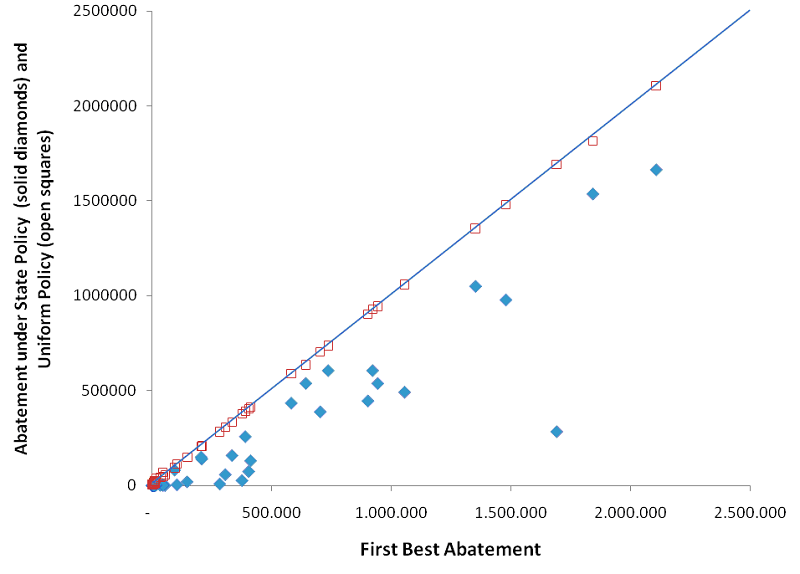Environmental pollution typically arises in the context of a federation with several levels of government. This raises the question of which level of government should address the problem. In a federal system like the US, should the central government or the individual states address environmental harms? Or, in the EU, should the EU itself or the individual nations do so?
Identifying the right level of government to address environmental problems is a dilemma because of pollution's distinctive spatial characteristics. Pollution's damages typically vary spatially. Air pollution, for example, does more damage if it is emitted upwind of a city than downwind. Moreover, pollution typically crosses jurisdictional borders – air pollution may travel thousands of miles.
The optimal policy would equate the marginal costs of abating pollution with the marginal benefits, across all jurisdictions – including spillovers. In practice, however, this ideal policy is unobtainable. The environmental federalism literature emphasises two policies which depart from the first best in opposite ways, serving as bookends (Oates 2002). Central governments are likely to impose a one-size-fits-all policy that ignores local heterogeneity. But in setting this uniform policy, they can take account of spillovers across local jurisdictions. In contrast, local jurisdictions can account for heterogeneity in local benefits and costs. Unfortunately they are likely to ignore inter-jurisdictional spillovers. These trade-offs represent the Scylla and the Charybdis of environmental federalism.
Research has demonstrated that both threats are sufficient to wreck the ship of environmental policy (Alm and Banzhaf 2010). On one side, it's clear that governments at least underestimate pollutants that cross into another jurisdiction. For example, Sigman (2002) finds worse pollution on international rivers than on domestic rivers around the world, suggesting a tendency to ignore international spillovers. Extending this work, Sigman (2007) finds that nations with more decentralised governments have higher levels of regional (but not local) pollution. In the US, Helland and Whitford (2003) find that large polluting facilities tend to be located near state borders. At the same time, imposing centralised one-size-fits-all policies can result in tremendous costs. For example, Dinan et al. (1999) consider federal drinking water standards. Because drinking water is a local public good with little or no spillover effects, local jurisdictions have an incentive to mandate the efficient level. By contrast, federal policy inefficiently imposes large costs on small jurisdictions, costing some households as much as $774 annually.
Which concern is more salient, heterogeneity in damages or inter-jurisdictional spillovers, will differ on a case-by-case basis. But is there any general guidance on which side to err? In recent research, we show that there is (Banzhaf and Chupp 2010). We show that if the following three conditions are met:
- the devolved policy involves the mistake of systematically under-pricing pollution (because of ignoring inter-jurisdictional policies);
- the centralised policy involves the mistake of noise around the optimal price (from imposing some average price); and
- marginal abatement costs are convex in abatement,
then marginal costs will tend to be more inelastic around the uniform policy. This tends to give the centralised policy an edge over devolved policies. Essentially, mispricing too high, as the centralised policy can sometimes do, causes fewer distortions than mispricing too low, as the local policies are almost sure to do.
We go on to test the importance of these factors empirically in perhaps the most important context for environmental policy over the past 50 years: ambient air pollution. In particular, we look at air-pollution policies in the US, using a highly detailed simulation model of the US electricity sector developed at Resources for the Future (Paul and Burtraw 2002). Using this model, we estimate a function relating the marginal costs of pollution abatement to the level of abatement in each state. We also estimate the marginal benefits of pollution abatement in each state based on downwind health effects.
We then compute the welfare gains, relative to a hypothetical baseline of no pollution control, of three incentive-based policies. The first policy is the first-best, which equates the marginal costs of abating pollution with the marginal benefits in all states. The second is the state-level policy, in which each state equates the marginal costs of abating pollution with the within-state marginal benefits, ignoring inter-jurisdictional spillovers. The third is the national policy, which considers spillovers but inefficiently imposes uniform marginal abatement costs on all states. Note all three policies may be either a Pigouvian tax, which directly sets a pollution price in the relevant jurisdiction, or a cap-and-trade system, which induces a single market-clearing pollution price.
Figure 1 illustrates our approach. It shows the estimated marginal cost of abatement in four states. The three horizontal lines represent three different pollution prices associated with the three policies. The optimal uniform price for the country as a whole is $3912, and this price is illustrated in each of the four panels. The higher of the other two prices is the total damages caused by emissions from that state; this is the first-best pollution price. The lower of the other two prices is the within-state damages; this is the pollution price the state would choose.
Figure 1. Marginal cost curves for SO2 abatement
Figure 1a. Louisiana
Figure 1b. Florida
Figure 1c. California.
Figure 1d. Illinois
We find that the annual net benefits of the fully differentiated first-best policy are $59.7 billion. Moreover, we find substantial spatial heterogeneity in damages. The optimal pollution price ranges from $1091/ton SO2 in Maine to $6199/ton SO2 in California. For comparison, prices for SO2 permits have ranged from $100 to $1600 in recent years. The states on their own are estimated to achieve national net benefits of $40.9 billion, simply acting out of their own self-interest. This is a loss of 31.5% of the total potential benefits, which is substantial, but perhaps smaller than one might have guessed. More surprising is that the second-best uniform policy, with an estimated pollution price of $3912, achieves net benefits of $59.6 billion, a loss of only 0.2% of the first-best.
In the case of US air pollution, the centralised policy outperforms the state policies for two reasons. First, inter-jurisdictional spillovers are simply more important than heterogeneity, though the latter is not trivial. On average, only 16% of marginal benefits are internalised within-state and prices are on average too low by $2592. State policies that ignore the other 84% of benefits are bound to be sub-optimal. By comparison, the average of the absolute value of the differences between the uniform price and the first-best price is $1092; the average of absolute percentage differences is 40%. These errors are about half that made under the state policies.
Figure 2 illustrates this relationship. This figure shows the pollution prices chosen by states under a devolved policy (solid diamonds) as well as the uniform price of $3912 (open squares) plotted against each states' respective optimal price. Departures from the 45-degree line reflect departures from optimal prices. Because the states under-abate, the solid diamonds are always under the 45-degree line. The uniform policy sometimes over-controls and sometimes under-controls. On balance, they are closer to the 45-degree line, indicating that errors in pricing are smaller for the uniform policy than for the states.
Figure 2. Pollution prices under state and uniform policies vs. first-best
The second reason the centralised policy outperforms the state policies is the way benefits interact with costs, as described above. As shown in Figure 1, our estimated marginal cost curves exhibit a good deal of convexity, and they are quite inelastic in the region of the uniform policy. Accordingly, errors in price signals correspond to small errors in abatement, and hence small welfare losses.
Figure 3 shows how the errors in pollution pricing of each respective policy translate into errors in the equilibrium level of abatement. It shows the abatement chosen by states under a devolved policy (solid diamonds) as well as each state's abatement under the uniform pollution price of $3912 (open squares), plotted against each states' respective optimal abatement. Again, departures from the 45-degree line reflect departures from optimal abatement. As shown in the figure, the open squares associated with the uniform policy are practically on the 45-degree line. Thus, despite the fact that the uniform policy's pollution price is not optimal in most states, the induced level of abatement essentially is. This is the reason that it captures 99.8% of the first-best benefits, despite the presence of spatial heterogeneity in pollution damages.
Figure 3. Abatement under state and uniform policies vs. first-best
Stepping back from these federalism questions, the first-order lesson of this research is that there are tremendous welfare gains to be had from reducing air pollution, however achieved. We estimate the net benefits of the second-best uniform policy to be $59.6 billion annually. This second-best uniform policy is not the same as the status quo policy in the US. It involves substantially more abatement. Thus, reducing the cap on conventional pollutants may be the most important policy reform (Banzhaf et al. 2004, Muller and Mendelsohn 2009).
References
Alm, James and H Spencer Banzhaf (2010), “Designing Economic Instruments for the Environment in a Decentralized System", Journal of Economic Surveys, forthcoming.
Banzhaf, H Spencer, Dallas Burtraw, and Karen Palmer (2004), "Efficient Emission Fees in the U.S. Electricity Sector", Resource and Energy Economics, 26:317-341.
Banzhaf, H Spencer, and B Andrew Chupp (2010), "Heterogeneous Harm vs. Spatial Spillovers: Which Level of Government Should Regulate US Air Pollution?", NBER Working Paper 15666, January.
Dinan, Terry, Maureen Cropper, and Paul Portney (1999), "Environmental Federalism: Welfare Losses from Uniform National Drinking Water Standards", A Panagariya, P Portney and R Schwab (eds.), Environmental and Public Economics: Essays in Honor of Wallace E. Oates, Elgar UK.
Helland, Eric, and Andrew Whitford (2003), "Pollution Incidence and Political Jurisdiction: Evidence from the TRI", Journal of Environmental Economics and Management, 46:403-424.
Muller, Nicholas and Robert Mendelsohn (2009), "Efficient Pollution Regulation: Getting the Prices Right", American Economic Review 99:1714-1739.
Oates, Wallace E (2002), "A Reconsideration of Environmental Federalism", in JA List and A d Zeeuw (eds.), Recent Advances in Environmental Economics, Elgar UK.
Paul, Anthony and Dallas Burtraw (2002), "The RFF Haiku Electricity Market Model", Washington, DC, Resources for the Future.
Sigman, Hilary (2002), "International Spillovers and Water Quality in Rivers: Do Countries Free Ride?", The American Economic Review. 92(4):1152-1159.
Sigman, Hilary A (2007), "Decentralization and Environmental Quality: An International Analysis of Water Pollution", Working Paper w13098. Cambridge, MA: National Bureau of Economic Research.
